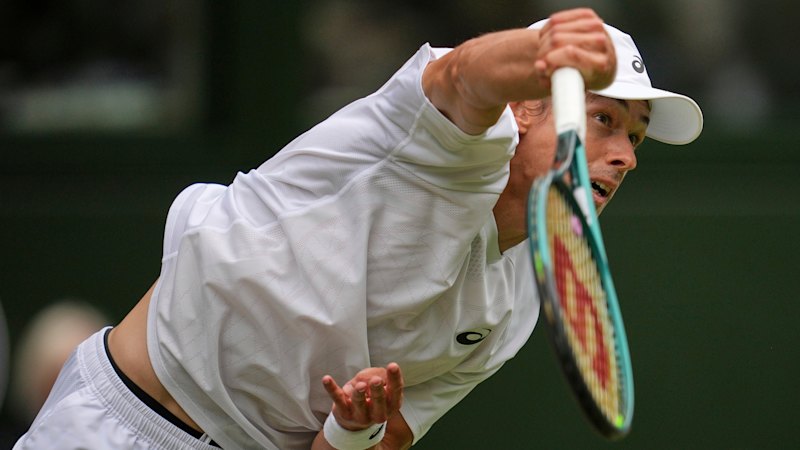
The five-time major quarter-finalist’s percentage of unreturned first serves for the tournament was only 34 per cent (73/212), which ranked equal-98th in the men’s draw.
De Minaur tested Novak Djokovic in a high-quality fourth-round contest at Wimbledon.Credit: Getty Images
Woodbridge spoke with a still-disappointed de Minaur in the hours after his four-set defeat to Djokovic. De Minaur’s serve was among the topics.
“Alex was playing against a guy [Djokovic] who has adjusted his serve throughout his career and made it better – and that’s the example you have to look at,” Woodbridge said.
“He’s got a great team of people around him, got all the technology, and now it’s time to go back and keep tweaking the technique.
Loading
“He’s got to rotate his shoulders, get his right shoulder back, and get more turn and torque. What he does is take the racquet head out to the right, and that opens him up, and he gets too front-on.
“That [results in] lack of control and trajectory. The best players have great shoulder rotation, hold it in there, and then they uncoil.”
Respected Australian coach Craig O’Shannessy made the same observation about de Minaur’s front-on service motion, and said fixing that was not about adding more power but instead would add much-needed serving accuracy.
ATP Tour serving analysis last year of the top-20 men’s players found that de Minaur was by far the least accurate in that group, based on placement in the service box.
That continued at Wimbledon this year, where the Australian’s serves went to the body, rather than the corners, about five times more often than Djokovic and Jannik Sinner. O’Shannessy, who previously worked with Djokovic, said that was an accuracy issue for de Minaur and not a deliberate strategy.
The key serve numbers for Alex de Minaur at Wimbledon.Credit: Wimbledon website / IBM
“Alex is hitting it in the strike zone [too often] … he’s losing so many points because the opponent is ready for that,” O’Shannessy told this masthead.
“From a placement perspective, Novak is serving only [about] three per cent at the body, and everything else is an even mix, so it makes it almost impossible to do a game plan against him.
“Alex has to improve his technique. He has to stay sideways longer. The lower body’s got to rotate and stop, and the upper body then receives that energy and throws that into the arm. He’s over-rotating with [both], and then he’s too front-on.”
Djokovic boasts remarkable serving accuracy in 2025 and at this Wimbledon.
Almost half Djokovic’s serves on the deuce and advantage sides landed wide or down the T, compared to between two and four per cent to the body, according to IBM tracking data.
De Minaur, on the other hand, had about 50 per cent down the T on each side at Wimbledon, but went wide on only 28 and 36 per cent of serves, respectively, on the advantage and deuce sides.
Loading
He was at 20 and 17 per cent to the body on the advantage and deuce sides, respectively. Interestingly, Carlos Alcaraz’s percentage of serves to the body this event is even higher than de Minaur.
However, Woodbridge said de Minaur should not beat himself up about the Djokovic defeat or become too preoccupied with his serving deficiencies.
“Alex is a legitimate top-10 player. The hardest part in this game is getting there, and then it’s even harder to stay there – but he’s proven he can do that,” Woodbridge said.
“I said to him [post-match], ‘Don’t you dare tell me that you’re not good enough to be in this space. You’re 10 times better a tennis player than I ever was, and a lot of us were, so take your strengths, keep them, and keep working on those small bits that can make you better’.”





